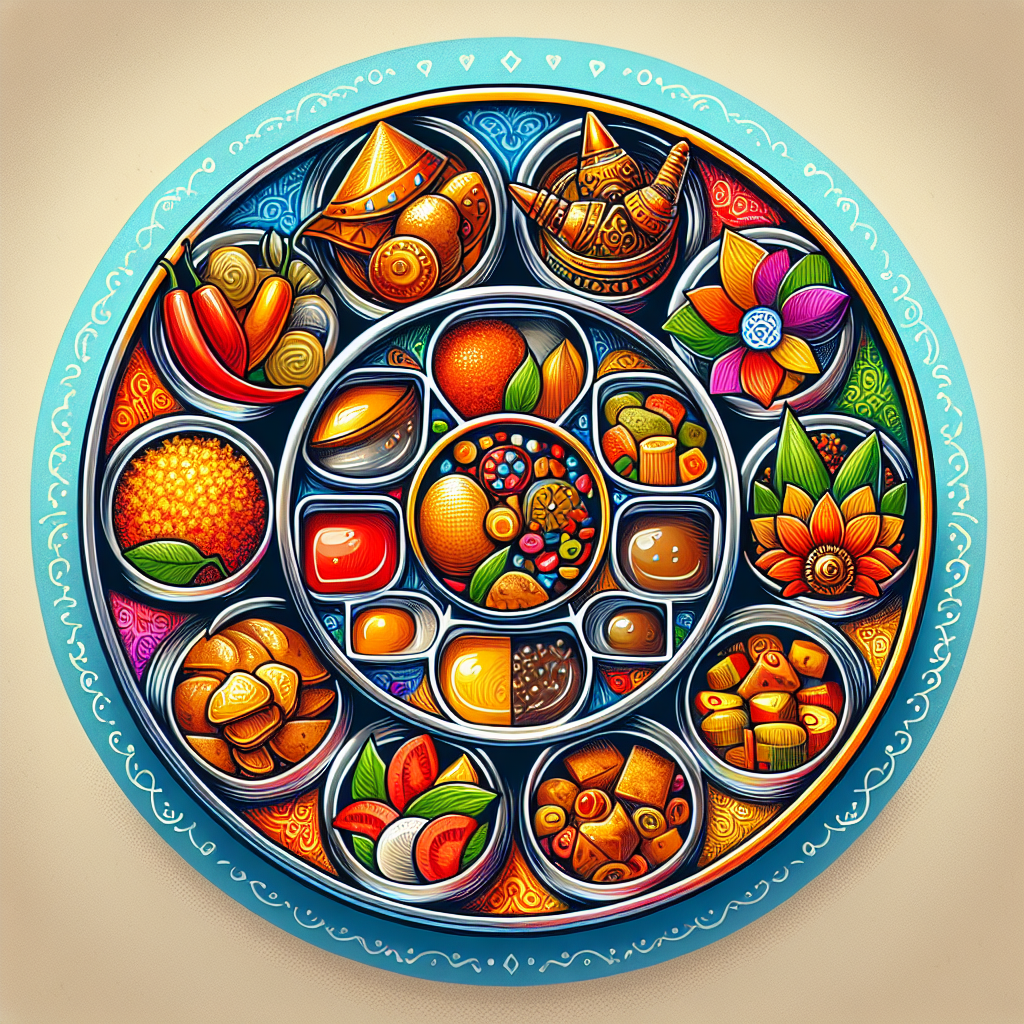Immerse yourself in the vibrant world of Indian folklore and myths as we explore the significant role that food plays in this rich cultural tapestry. Indulge your senses and savor the flavors of India’s diverse cuisine, which holds a deep connection to ancient tales and traditions. Discover the aromatic spices and regional specialties that bring these folklore and myths to life, and gain a deeper understanding of how food has shaped and defined Indian culture throughout history. Get ready to embark on a culinary journey that will leave you both satisfied and enlightened.

Introduction
Food holds a significant place in Indian culture, not just as sustenance but as a symbol of wealth, love, spirituality, and purity. It is deeply intertwined with Indian folklore and mythology, reflecting the rich history, traditions, and values of the country. From offerings made to deities to the symbolism of specific foods in myths, Indian folklore and myths depict the importance of food in various aspects of life. Additionally, rituals and traditions associated with Indian food, historical and cultural influences on Indian cuisine, and even the influence of Indian food in literature and art, further highlight its significance in Indian society. As India evolves in the modern era, it becomes crucial to preserve the country’s food culture and heritage. This article will explore the role of food in Indian folklore and myths, shedding light on its symbolism, traditions, and the need for preservation.
1. Food as a Symbol in Indian Folklore
1.1 Food as a Representation of Wealth and Abundance
In Indian folklore, food is often portrayed as a symbol of wealth and abundance. The presence of a richly-laden banquet table or the description of a grand feast signifies prosperity and affluence. Meals prepared with generous amounts of ghee, spices, and exotic ingredients showcase opulence and abundance. These depictions serve as a metaphorical representation of the desire for prosperity and well-being in Indian society.
1.2 Food as a Symbol of Love and Care
Food holds an immense emotional value in Indian culture, symbolizing love, care, and nurturing. The act of preparing and serving food to loved ones is seen as an expression of affection and concern. In Indian folklore, the portrayal of a mother or grandmother cooking a favorite dish for their children or family members signifies the deep bonds of love and the desire to nurture and provide comfort through food.
1.3 Food as a Way of Connecting with Ancestors
In Indian folklore, food is considered a medium for connecting with ancestors and seeking their blessings. During festivals and ancestral rituals, specific foods are prepared and offered to honor the departed souls. These offerings are believed to nourish and satisfy the spirits, ensuring their continued presence and blessings in the family. By sharing food with their ancestors, individuals express their respect, gratitude, and desire for a harmonious relationship with their lineage.
1.4 Food as a Symbol of Purity and Ritual
In Indian folklore, certain foods are associated with purity and ritualistic practices. Ingredients like ghee, milk, and honey are believed to possess purifying properties and are used in sacred rituals. For example, during religious ceremonies, ghee is offered in the sacred fire, symbolizing the purity of intentions and actions. Similarly, the consumption of specific foods, such as fruits and sweets, during religious festivals signifies the pursuit of spiritual purity and divine blessings.

2. Importance of Food in Indian Myths and Epics
2.1 Food Offerings to Deities
Offering food to deities is a significant practice in Indian myths and epics. Devotees prepare elaborate meals and present them as offerings to their chosen deities, seeking their blessings and protection. These offerings, known as prasadam, are considered divine and are distributed among the devotees after being blessed by the gods. By offering food to the deities, individuals express their gratitude and devotion, forging a spiritual connection.
2.2 Food-Related Rituals in Religious Ceremonies
Religious ceremonies in India often involve specific food-related rituals. For instance, the breaking of a coconut during Hindu ceremonies symbolizes the surrender of the ego and offering the self to the divine. Similarly, the act of breaking bread or sharing a meal together in religious gatherings promotes unity, brotherhood, and a sense of community.
2.3 Food as a Means of Attaining Spiritual Enlightenment
In Indian mythology and epics, food is occasionally depicted as a means of attaining spiritual enlightenment. Stories often narrate how certain characters achieved profound wisdom or divine blessings through consuming specific foods or observing strict dietary practices. This portrayal emphasizes the belief that balanced and mindful consumption of food can lead to spiritual growth and enlightenment.
2.4 Symbolism of Specific Foods in Indian Myths
Indian myths abound with symbolism associated with specific foods. For instance, in the story of Ramayana, the golden deer is portrayed as an illusion to tempt the protagonist, Lord Rama, highlighting the deceptive nature of material desires. Similarly, the peacock feather worn by Lord Krishna represents his connection with nature and highlights his love for butter, a food symbolizing purity, nourishment, and devotion.
3. Rituals and Traditions Associated with Indian Food
3.1 Festivals and the Role of Food
Festivals in India are often accompanied by specific food traditions and rituals. For instance, during Diwali, the Festival of Lights, families prepare traditional sweets such as jalebi and gulab jamun, symbolizing the sweetness and joy of the occasion. Similarly, during Eid, the end of Ramadan, Muslims prepare a special feast consisting of biryani, kebabs, and sweets, marking the celebration and gratitude for the month of fasting.
3.2 Sacred Foods and Their Significance
Certain foods are considered sacred in Indian culture and are believed to possess divine properties. For instance, tulsi leaves (holy basil) are considered auspicious and are used in religious rituals. The consumption of foods like panchamrut (a mixture of milk, honey, curd, ghee, and sugar) during religious ceremonies is believed to purify the body, mind, and soul, reinforcing a spiritual connection with the divine.
3.3 Fasting and Its Spiritual Significance
Fasting holds immense importance in Indian culture and is associated with various spiritual beliefs. Whether observed for religious reasons or personal purification, fasting is seen as a means of self-discipline and spiritual growth. During fasting, individuals abstain from certain foods or fast entirely, engaging in prayer, meditation, and self-reflection. Fasting is believed to detoxify and purify the body and mind, strengthening one’s spiritual connection.
3.4 Regional Food Traditions in India
India’s diverse regional cuisines are a testament to its rich cultural heritage. Each region boasts its unique food traditions and culinary practices. From the spicy curries of South India to the flavorful kebabs of the North, regional food traditions represent the distinct socio-cultural identities of their respective communities. These traditions are often passed down through generations, preserving the essence of regional cuisine.

4. Historical and Cultural Influences on Indian Food
4.1 Ancient Trade and Exchange of Culinary Practices
India’s geographical location has facilitated the exchange of culinary practices with various civilizations throughout history. Ancient trade routes brought in influences from Central Asia, the Middle East, and other regions, enriching Indian cuisine. The introduction of ingredients such as rice, spices, and even cooking techniques profoundly influenced Indian food. These historical influences are still visible in the diverse flavors and cooking styles of Indian cuisine today.
4.2 Caste System and Its Influence on Food
The caste system, albeit a social construct, had significant influence on Indian food practices for centuries. Different castes were associated with specific occupations, including cooking and food preparation. Brahmins, the priestly class, were traditionally responsible for preparing and offering food to deities and played a pivotal role in shaping food-associated rituals. The caste system also affected dietary restrictions, with certain castes following vegetarianism and others consuming meat.
4.3 Colonial Impact on Indian Cuisine
India’s colonization by various European powers also left a lasting impact on its cuisine. The Portuguese, Dutch, French, and British introduced new ingredients, cooking techniques, and food styles, which gradually assimilated into Indian food culture. The advent of chili peppers, potatoes, and tomatoes in Indian cuisine through colonial influence showcases how these ingredients are now integral to traditional Indian cooking.
4.4 Fusion of Indian and Foreign Culinary Traditions
In recent years, Indian cuisine has witnessed the fusion of Indian and foreign culinary traditions. The globalization of food has led to the emergence of fusion cuisine, where traditional Indian flavors are combined with elements of international cuisines. This blending of cuisines reflects the evolving tastes and preferences of a globalized India while preserving the essence of its rich culinary heritage.
5. Folklore Tales and Myths Surrounding Indian Food
5.1 The Legend of Soma and Its Connection to Food
The ancient Indian text, Rigveda, mentions the legendary drink called Soma, often associated with food and the gods. Soma is believed to grant immortality and bestow divine knowledge upon those who consume it. The significance of Soma in Indian folklore underscores the association of food and drink with divine blessings and spiritual enlightenment.
5.2 The Story of Krishna and His Love for Butter
In Indian mythology, Lord Krishna’s love for butter, particularly the stealing of butter from gopis’ homes, has captured popular imagination. This story represents the childlike innocence and playfulness of Lord Krishna and is often depicted through art, music, and dance. It also symbolizes the devotion and the pursuit of divine love that transcends material possessions.
5.3 The Myth of the Cursed Mango
In Indian mythology, the tale of the cursed mango revolves around the sage Durvasa and Lord Indra. The story teaches the importance of humility, respect, and the consequences of disregarding the power of blessings. The cursed mango is a reminder that food shared should be done with utmost reverence and gratitude, ensuring blessings rather than curses.
5.4 The Tale of the Holy Cow and Its Association with Vegetarianism
The cow holds a sacred place in Indian mythology and is often associated with food and vegetarianism. Lord Krishna, a vegetarian, is depicted as a cowherd, showcasing the reverence for cows in Hindu culture. The tale of the holy cow highlights the belief in the sacredness of all life forms and the principle of ahimsa (non-violence), an essential aspect of Indian vegetarianism.
6. Traditional Indian Ingredients and Their Symbolism
6.1 Spices and Their Metaphorical Significance
Indian cuisine is renowned for its vibrant and aromatic spices, each carrying its symbolic significance. For example, turmeric represents auspiciousness and purification, while cardamom symbolizes warmth and love. The use of spices in Indian cooking goes beyond culinary purposes, signifying cultural identity, and reflecting the multidimensional role of food in Indian life.
6.2 Rice and Its Role in Indian Folklore
Rice, a staple grain in Indian cuisine, holds immense cultural and symbolic value. It is often associated with fertility, prosperity, and sustenance. Indian folklore features tales of rice being a divine gift bestowed upon humanity, emphasizing its significance as a primary source of nourishment and the foundation of sustenance.
6.3 Lentils and the Symbolism of Sustenance
Lentils, or dal, form a fundamental part of Indian cuisine and play a role in Indian folklore as symbols of sustenance. Dal is often described as the “poor man’s meat,” showcasing its nutritional value and ability to provide nourishment. Its presence in traditional meals signifies abundance, contentment, and the importance of balanced nutrition.
6.4 Ghee and Its Sacred Value
Ghee, clarified butter, holds a sacred place in Indian culture and cuisine. Its symbolic value transcends its culinary use, signifying purity, auspiciousness, and spiritual nourishment. Ghee is used in religious ceremonies, both as an offering and as an ingredient, and is believed to have purifying properties for the mind, body, and soul.
7. Influence of Indian Food in Literature and Art
7.1 Descriptions of Food in Indian Literature
Food features prominently in Indian literature, describing not just the flavors but also the emotional and cultural significance of various dishes. Authors paint vivid pictures of meals, feasts, and culinary traditions, allowing readers to immerse themselves in the sensory experience of Indian cuisine through words. These literary descriptions serve not only to entertain but also to preserve and pass on cultural and culinary heritage.
7.2 Food Motifs in Indian Paintings and Sculptures
Indian paintings and sculptures often incorporate food motifs, portraying food as a subject of artistic expression. These depictions showcase the cultural significance of food, its visual appeal, and the pleasure it brings. From intricate still-life paintings of fruits and delicacies to sculptures depicting offerings and rituals, Indian art encapsulates the deep connection between food, culture, and aesthetics.
7.3 Food Symbolism in Indian Performing Arts
Indian performing arts, such as dance and theater, often utilize food symbolism in their narratives. Dance forms like Kathakali and Bharatanatyam portray tales from mythology and folklore, with dancers using elaborate hand gestures and expressions to depict the offering, preparation, or consumption of food. These performances breathe life into food-related stories, engaging the audience and conveying their symbolic meanings.
7.4 Culinary References in Indian Cinema
Indian cinema has been quick to recognize the cultural significance of food and has incorporated culinary references into its storytelling. Films often showcase scenes of cooking, feasting, and sharing food as a means of portraying familial bonds, celebrations, and cultural traditions. These cinematic portrayals reinforce the emotional and societal importance of food in Indian culture.
8. Evolving Food Practices in Modern India
8.1 Impact of Globalization on Indian Cuisine
The advent of globalization and increased connectivity has had a profound impact on Indian cuisine. Globalization has transformed the availability and accessibility of ingredients, leading to the integration of international flavors and cooking techniques into Indian dishes. The rise of fusion cuisine, fusion restaurants, and culinary innovations has expanded the culinary landscape of India, reflecting the evolving tastes and preferences of a globalized society.
8.2 Changing Dietary Preferences
As India continues to experience rapid urbanization and cultural shifts, dietary preferences have also undergone changes. With exposure to global cuisines and changing lifestyles, there is an increasing demand for convenience foods, fast food, and processed snacks. However, traditional Indian cuisine still holds a strong place in the hearts and minds of many, with a growing movement towards preserving and promoting indigenous ingredients and traditional recipes.
8.3 Fusion and Innovation in Indian Culinary Practices
The fusion of diverse culinary traditions has given rise to innovative and progressive approaches to Indian cuisine. Chefs and food enthusiasts experiment with ingredients, flavors, and presentation styles, blending traditional and contemporary techniques to create unique culinary experiences. This fusion and innovation showcase the culinary prowess of India, bridging the gap between tradition and modernity.
8.4 Health and Sustainability in the Indian Food Industry
The Indian food industry is witnessing a growing emphasis on health consciousness and sustainability. With increasing awareness about the impact of food choices on personal well-being and the environment, there is a shift towards organic, locally-sourced, and plant-based ingredients. Sustainable practices, such as reducing food waste and promoting ethical farming, are gaining traction, contributing to a more conscious and responsible food culture in modern India.
9. Preserving Indian Food Culture and Heritage
9.1 Importance of Documenting Traditional Recipes
Preserving traditional recipes is essential to safeguarding Indian food culture and heritage. The documentation of recipes ensures that culinary practices are passed down through generations, safeguarding the authenticity and flavors of traditional dishes. Archiving traditional recipes also plays a crucial role in promoting cultural diversity, regional specialties, and culinary techniques that may otherwise be lost in a rapidly changing world.
9.2 Revival of Regional Culinary Practices
India’s regional culinary practices are a treasure trove of traditional knowledge and flavors. To preserve this rich culinary heritage, there is a need for concerted efforts to revive regional culinary practices. Initiatives that focus on promoting regional ingredients, traditional cooking methods, and showcasing regional specialties contribute to the preservation and appreciation of India’s diverse food culture.
9.3 Promoting Awareness and Appreciation of Indian Food
Educating people about the cultural significance and diversity of Indian food is crucial for its preservation. By promoting awareness and appreciation, individuals can develop a deeper understanding of Indian culinary traditions, fostering respect for its heritage. Encouraging participation in food festivals, cooking workshops, and culinary tours not only exposes individuals to the flavors of India but also promotes cultural exchange and appreciation.
9.4 Supporting Local Farmers and Sustainable Food Practices
Supporting local farmers and sustainable food practices is vital for the preservation of Indian food culture. By prioritizing the use of locally-sourced ingredients, consumers can contribute to the growth of traditional farming communities and help preserve heirloom crops. Additionally, promoting sustainable and ethical food practices, such as reducing food waste and adopting eco-friendly packaging, minimizes the environmental impact of the food industry and promotes a more sustainable future.
In conclusion, food holds a deep-rooted significance in Indian folklore and myths, playing a multifaceted role in reflecting the country’s history, traditions, and values. From symbolizing wealth and love to connecting with ancestors and purifying the spirit, food actively weaves its way into every aspect of Indian life. Whether it is the rituals and traditions associated with Indian food, the historical and cultural influences shaping its cuisine, or the preservation of Indian food culture and heritage, the importance of food in Indian society cannot be overstated. As India embraces modernity, it becomes essential to preserve, appreciate, and sustain the country’s culinary traditions, ensuring that the flavors, symbolism, and cultural identity of Indian cuisine endure for generations to come.
